Developing a Media Plan: Toy Advertising and Marketing Strategy
VerifiedAdded on 2023/06/12
|8
|1531
|111
Report
AI Summary
This document presents a media plan designed to advertise and market a toy for children aged 6 to 15. The plan details the segmentation and profiling of target customers, focusing on understanding the preferences of both children and their parents. It outlines key actions, including defining market strategies, evaluating audience responses, and ensuring sufficient sales generation. The schedule includes advertising across various channels such as digital media, television, newspapers, and promotional events, primarily concentrated around the Christmas season. The rationale behind the advertising strategy involves pricing the product affordably for middle and high-income families and utilizing interactive media to engage children. Alternative media vehicles, such as viral marketing, are also suggested. The plan specifies reach and frequency requirements for advertising media, emphasizes creative messaging to capture children's attention, and addresses media merchandising requirements, legal constraints, and methods for testing media vehicles. This comprehensive media plan aims to maximize the product's market penetration and sales.

Running head: MEDIA PLAN
Media Plan
Name of the Student:
Name of the University:
Author Note:
Media Plan
Name of the Student:
Name of the University:
Author Note:
Paraphrase This Document
Need a fresh take? Get an instant paraphrase of this document with our AI Paraphraser
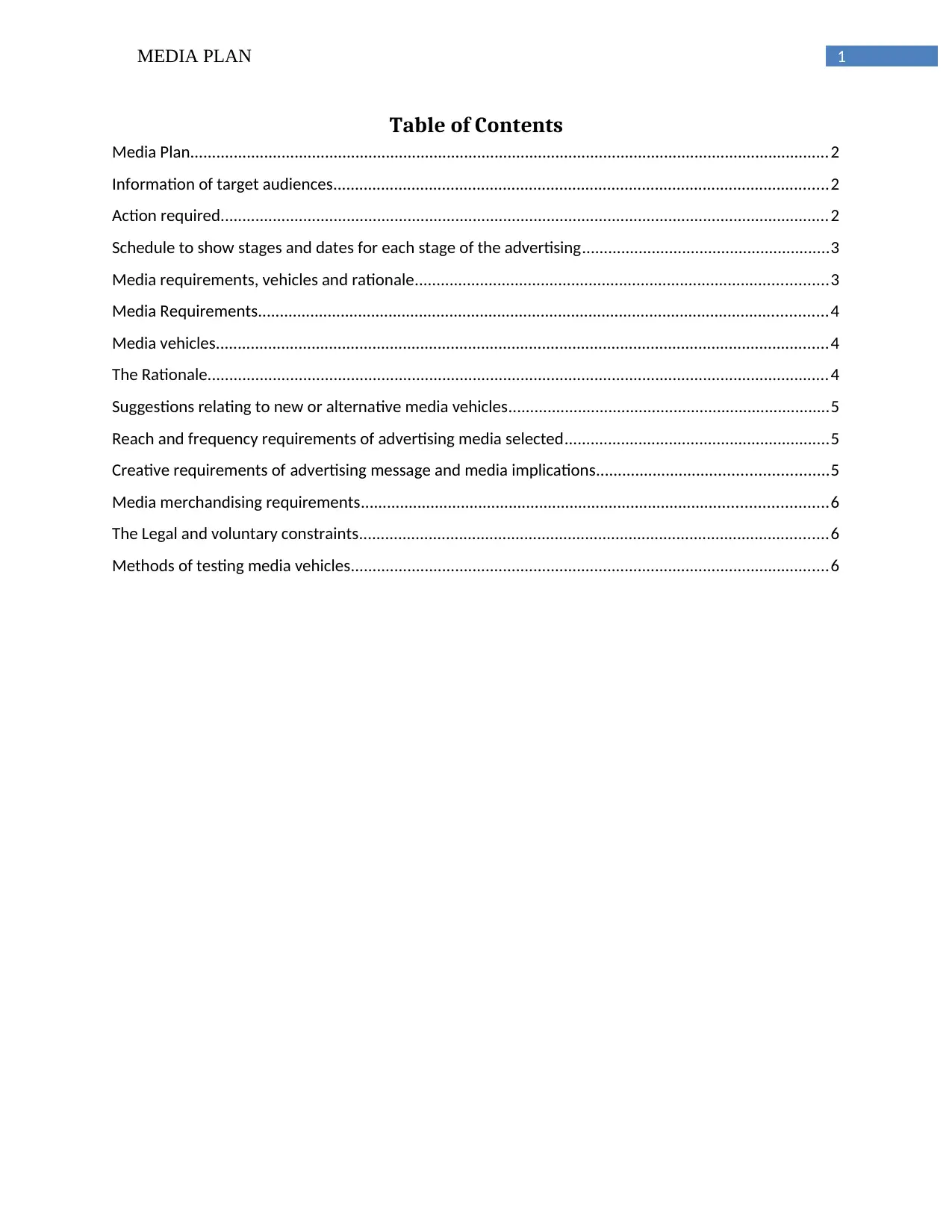
1MEDIA PLAN
Table of Contents
Media Plan...................................................................................................................................................2
Information of target audiences..................................................................................................................2
Action required............................................................................................................................................2
Schedule to show stages and dates for each stage of the advertising.........................................................3
Media requirements, vehicles and rationale...............................................................................................3
Media Requirements...................................................................................................................................4
Media vehicles.............................................................................................................................................4
The Rationale...............................................................................................................................................4
Suggestions relating to new or alternative media vehicles..........................................................................5
Reach and frequency requirements of advertising media selected.............................................................5
Creative requirements of advertising message and media implications.....................................................5
Media merchandising requirements...........................................................................................................6
The Legal and voluntary constraints............................................................................................................6
Methods of testing media vehicles..............................................................................................................6
Table of Contents
Media Plan...................................................................................................................................................2
Information of target audiences..................................................................................................................2
Action required............................................................................................................................................2
Schedule to show stages and dates for each stage of the advertising.........................................................3
Media requirements, vehicles and rationale...............................................................................................3
Media Requirements...................................................................................................................................4
Media vehicles.............................................................................................................................................4
The Rationale...............................................................................................................................................4
Suggestions relating to new or alternative media vehicles..........................................................................5
Reach and frequency requirements of advertising media selected.............................................................5
Creative requirements of advertising message and media implications.....................................................5
Media merchandising requirements...........................................................................................................6
The Legal and voluntary constraints............................................................................................................6
Methods of testing media vehicles..............................................................................................................6
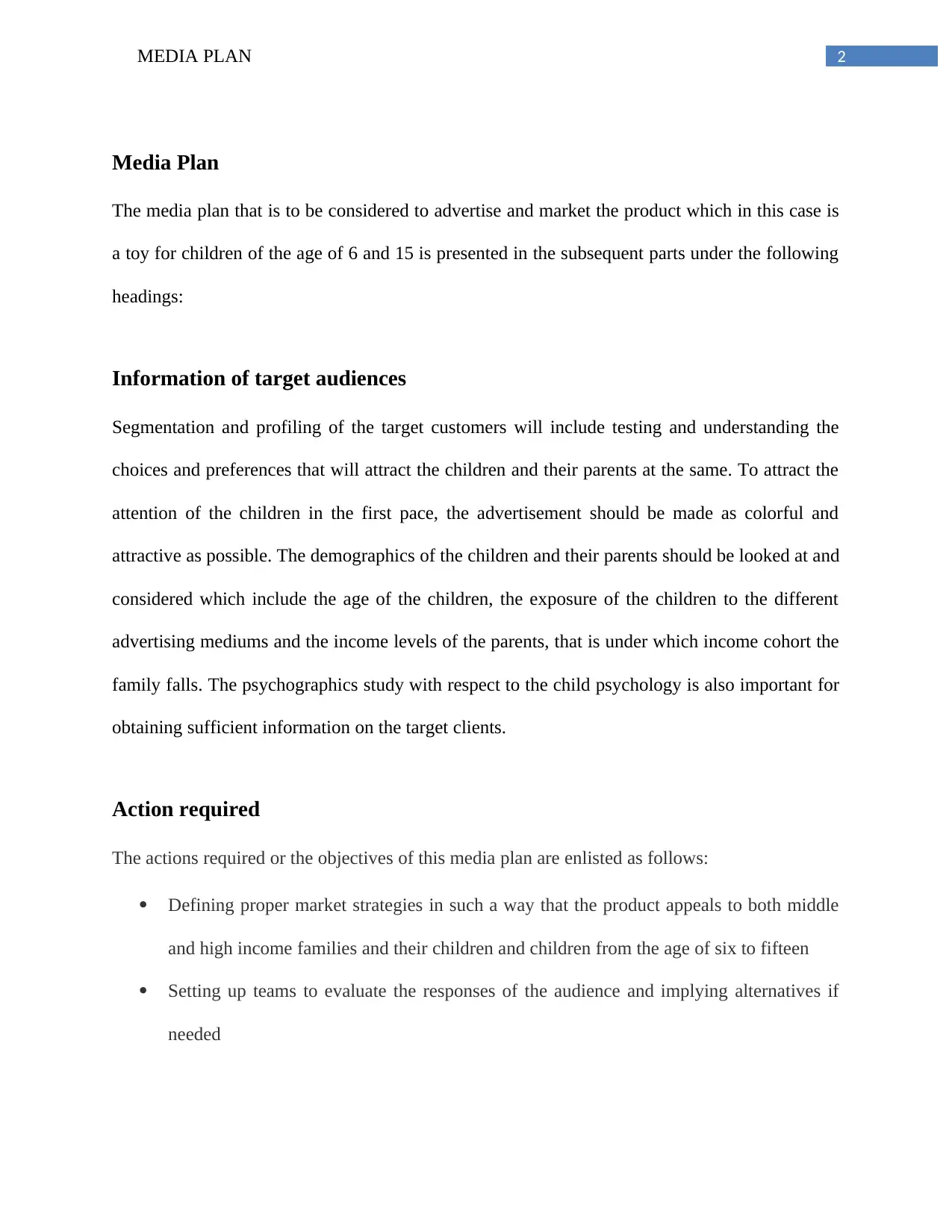
2MEDIA PLAN
Media Plan
The media plan that is to be considered to advertise and market the product which in this case is
a toy for children of the age of 6 and 15 is presented in the subsequent parts under the following
headings:
Information of target audiences
Segmentation and profiling of the target customers will include testing and understanding the
choices and preferences that will attract the children and their parents at the same. To attract the
attention of the children in the first pace, the advertisement should be made as colorful and
attractive as possible. The demographics of the children and their parents should be looked at and
considered which include the age of the children, the exposure of the children to the different
advertising mediums and the income levels of the parents, that is under which income cohort the
family falls. The psychographics study with respect to the child psychology is also important for
obtaining sufficient information on the target clients.
Action required
The actions required or the objectives of this media plan are enlisted as follows:
Defining proper market strategies in such a way that the product appeals to both middle
and high income families and their children and children from the age of six to fifteen
Setting up teams to evaluate the responses of the audience and implying alternatives if
needed
Media Plan
The media plan that is to be considered to advertise and market the product which in this case is
a toy for children of the age of 6 and 15 is presented in the subsequent parts under the following
headings:
Information of target audiences
Segmentation and profiling of the target customers will include testing and understanding the
choices and preferences that will attract the children and their parents at the same. To attract the
attention of the children in the first pace, the advertisement should be made as colorful and
attractive as possible. The demographics of the children and their parents should be looked at and
considered which include the age of the children, the exposure of the children to the different
advertising mediums and the income levels of the parents, that is under which income cohort the
family falls. The psychographics study with respect to the child psychology is also important for
obtaining sufficient information on the target clients.
Action required
The actions required or the objectives of this media plan are enlisted as follows:
Defining proper market strategies in such a way that the product appeals to both middle
and high income families and their children and children from the age of six to fifteen
Setting up teams to evaluate the responses of the audience and implying alternatives if
needed
⊘ This is a preview!⊘
Do you want full access?
Subscribe today to unlock all pages.

Trusted by 1+ million students worldwide
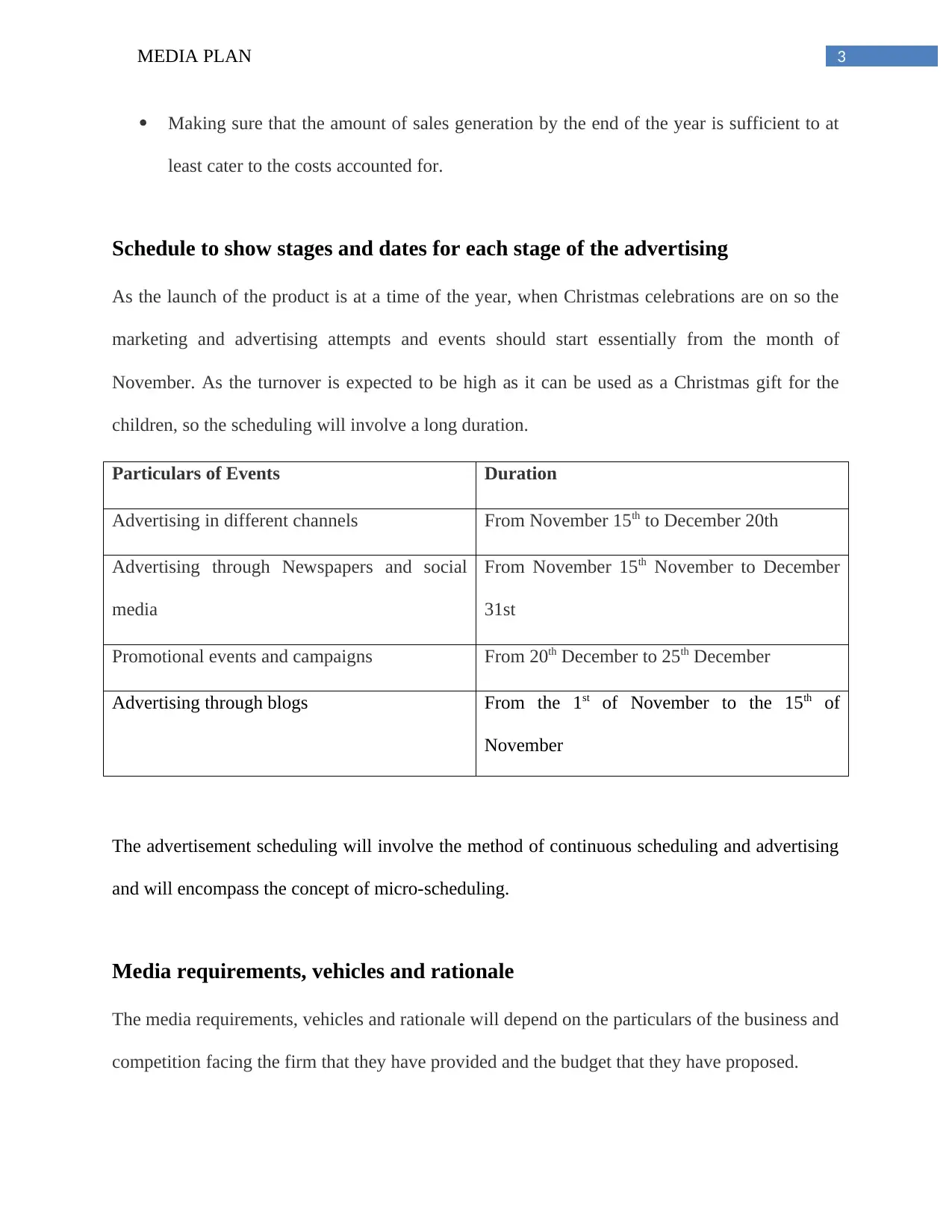
3MEDIA PLAN
Making sure that the amount of sales generation by the end of the year is sufficient to at
least cater to the costs accounted for.
Schedule to show stages and dates for each stage of the advertising
As the launch of the product is at a time of the year, when Christmas celebrations are on so the
marketing and advertising attempts and events should start essentially from the month of
November. As the turnover is expected to be high as it can be used as a Christmas gift for the
children, so the scheduling will involve a long duration.
Particulars of Events Duration
Advertising in different channels From November 15th to December 20th
Advertising through Newspapers and social
media
From November 15th November to December
31st
Promotional events and campaigns From 20th December to 25th December
Advertising through blogs From the 1st of November to the 15th of
November
The advertisement scheduling will involve the method of continuous scheduling and advertising
and will encompass the concept of micro-scheduling.
Media requirements, vehicles and rationale
The media requirements, vehicles and rationale will depend on the particulars of the business and
competition facing the firm that they have provided and the budget that they have proposed.
Making sure that the amount of sales generation by the end of the year is sufficient to at
least cater to the costs accounted for.
Schedule to show stages and dates for each stage of the advertising
As the launch of the product is at a time of the year, when Christmas celebrations are on so the
marketing and advertising attempts and events should start essentially from the month of
November. As the turnover is expected to be high as it can be used as a Christmas gift for the
children, so the scheduling will involve a long duration.
Particulars of Events Duration
Advertising in different channels From November 15th to December 20th
Advertising through Newspapers and social
media
From November 15th November to December
31st
Promotional events and campaigns From 20th December to 25th December
Advertising through blogs From the 1st of November to the 15th of
November
The advertisement scheduling will involve the method of continuous scheduling and advertising
and will encompass the concept of micro-scheduling.
Media requirements, vehicles and rationale
The media requirements, vehicles and rationale will depend on the particulars of the business and
competition facing the firm that they have provided and the budget that they have proposed.
Paraphrase This Document
Need a fresh take? Get an instant paraphrase of this document with our AI Paraphraser
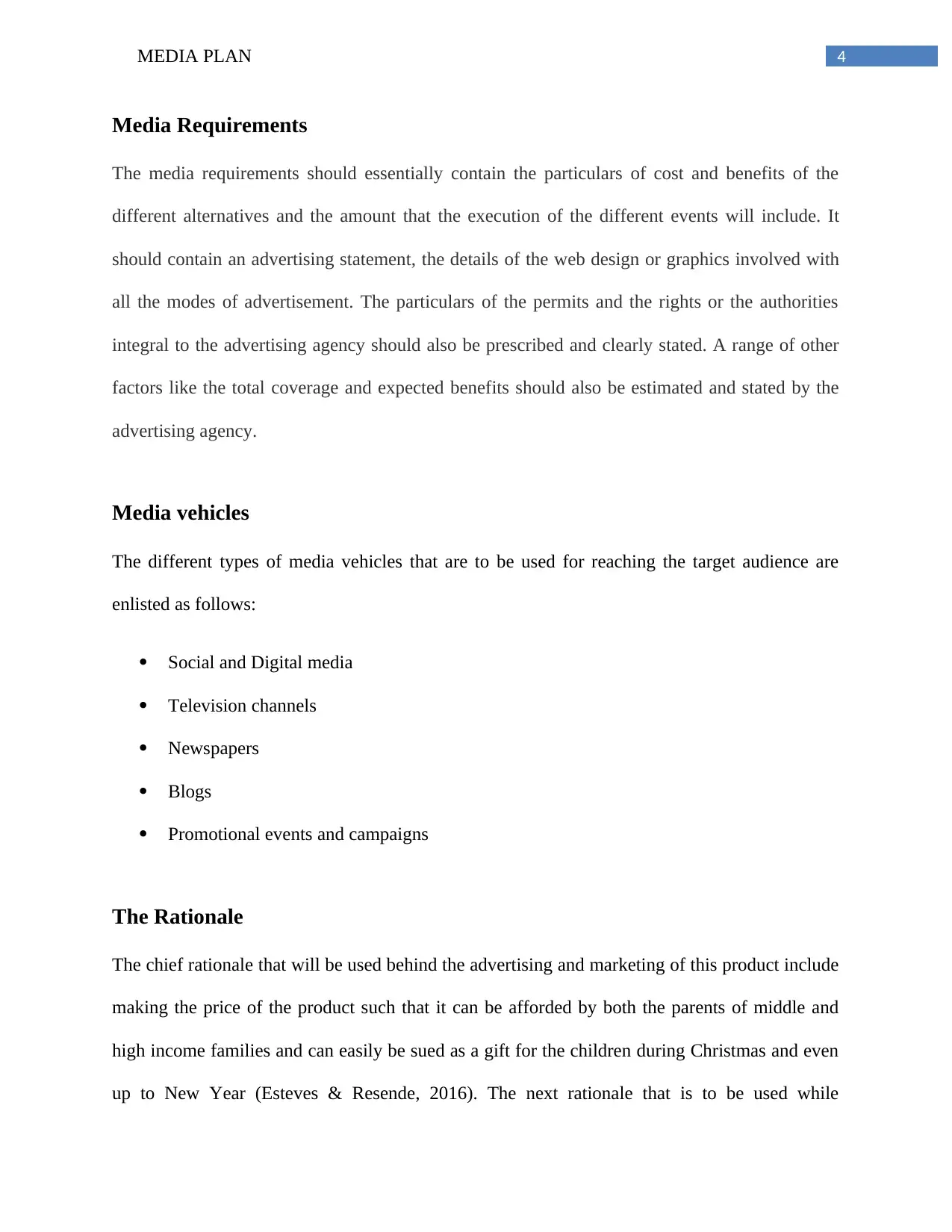
4MEDIA PLAN
Media Requirements
The media requirements should essentially contain the particulars of cost and benefits of the
different alternatives and the amount that the execution of the different events will include. It
should contain an advertising statement, the details of the web design or graphics involved with
all the modes of advertisement. The particulars of the permits and the rights or the authorities
integral to the advertising agency should also be prescribed and clearly stated. A range of other
factors like the total coverage and expected benefits should also be estimated and stated by the
advertising agency.
Media vehicles
The different types of media vehicles that are to be used for reaching the target audience are
enlisted as follows:
Social and Digital media
Television channels
Newspapers
Blogs
Promotional events and campaigns
The Rationale
The chief rationale that will be used behind the advertising and marketing of this product include
making the price of the product such that it can be afforded by both the parents of middle and
high income families and can easily be sued as a gift for the children during Christmas and even
up to New Year (Esteves & Resende, 2016). The next rationale that is to be used while
Media Requirements
The media requirements should essentially contain the particulars of cost and benefits of the
different alternatives and the amount that the execution of the different events will include. It
should contain an advertising statement, the details of the web design or graphics involved with
all the modes of advertisement. The particulars of the permits and the rights or the authorities
integral to the advertising agency should also be prescribed and clearly stated. A range of other
factors like the total coverage and expected benefits should also be estimated and stated by the
advertising agency.
Media vehicles
The different types of media vehicles that are to be used for reaching the target audience are
enlisted as follows:
Social and Digital media
Television channels
Newspapers
Blogs
Promotional events and campaigns
The Rationale
The chief rationale that will be used behind the advertising and marketing of this product include
making the price of the product such that it can be afforded by both the parents of middle and
high income families and can easily be sued as a gift for the children during Christmas and even
up to New Year (Esteves & Resende, 2016). The next rationale that is to be used while
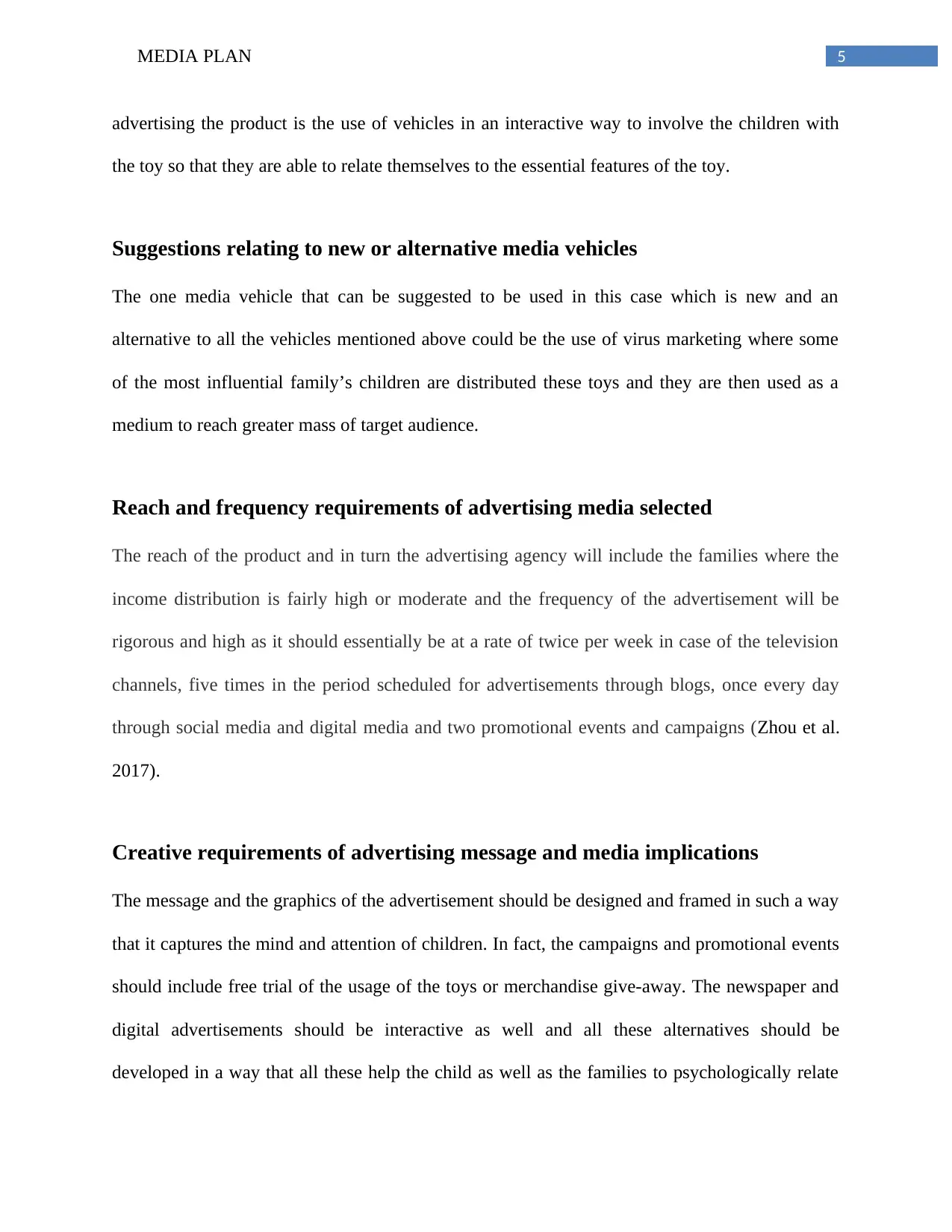
5MEDIA PLAN
advertising the product is the use of vehicles in an interactive way to involve the children with
the toy so that they are able to relate themselves to the essential features of the toy.
Suggestions relating to new or alternative media vehicles
The one media vehicle that can be suggested to be used in this case which is new and an
alternative to all the vehicles mentioned above could be the use of virus marketing where some
of the most influential family’s children are distributed these toys and they are then used as a
medium to reach greater mass of target audience.
Reach and frequency requirements of advertising media selected
The reach of the product and in turn the advertising agency will include the families where the
income distribution is fairly high or moderate and the frequency of the advertisement will be
rigorous and high as it should essentially be at a rate of twice per week in case of the television
channels, five times in the period scheduled for advertisements through blogs, once every day
through social media and digital media and two promotional events and campaigns (Zhou et al.
2017).
Creative requirements of advertising message and media implications
The message and the graphics of the advertisement should be designed and framed in such a way
that it captures the mind and attention of children. In fact, the campaigns and promotional events
should include free trial of the usage of the toys or merchandise give-away. The newspaper and
digital advertisements should be interactive as well and all these alternatives should be
developed in a way that all these help the child as well as the families to psychologically relate
advertising the product is the use of vehicles in an interactive way to involve the children with
the toy so that they are able to relate themselves to the essential features of the toy.
Suggestions relating to new or alternative media vehicles
The one media vehicle that can be suggested to be used in this case which is new and an
alternative to all the vehicles mentioned above could be the use of virus marketing where some
of the most influential family’s children are distributed these toys and they are then used as a
medium to reach greater mass of target audience.
Reach and frequency requirements of advertising media selected
The reach of the product and in turn the advertising agency will include the families where the
income distribution is fairly high or moderate and the frequency of the advertisement will be
rigorous and high as it should essentially be at a rate of twice per week in case of the television
channels, five times in the period scheduled for advertisements through blogs, once every day
through social media and digital media and two promotional events and campaigns (Zhou et al.
2017).
Creative requirements of advertising message and media implications
The message and the graphics of the advertisement should be designed and framed in such a way
that it captures the mind and attention of children. In fact, the campaigns and promotional events
should include free trial of the usage of the toys or merchandise give-away. The newspaper and
digital advertisements should be interactive as well and all these alternatives should be
developed in a way that all these help the child as well as the families to psychologically relate
⊘ This is a preview!⊘
Do you want full access?
Subscribe today to unlock all pages.

Trusted by 1+ million students worldwide
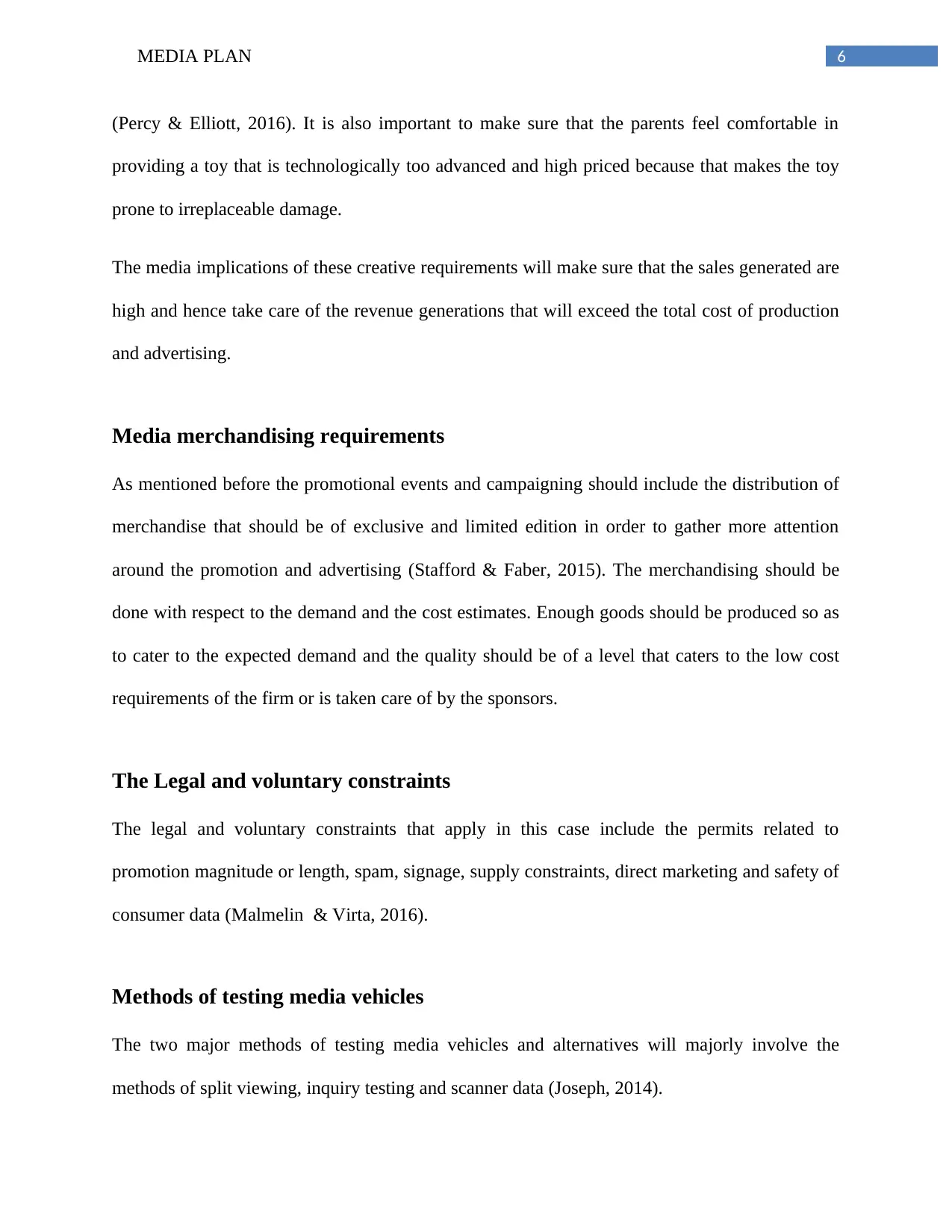
6MEDIA PLAN
(Percy & Elliott, 2016). It is also important to make sure that the parents feel comfortable in
providing a toy that is technologically too advanced and high priced because that makes the toy
prone to irreplaceable damage.
The media implications of these creative requirements will make sure that the sales generated are
high and hence take care of the revenue generations that will exceed the total cost of production
and advertising.
Media merchandising requirements
As mentioned before the promotional events and campaigning should include the distribution of
merchandise that should be of exclusive and limited edition in order to gather more attention
around the promotion and advertising (Stafford & Faber, 2015). The merchandising should be
done with respect to the demand and the cost estimates. Enough goods should be produced so as
to cater to the expected demand and the quality should be of a level that caters to the low cost
requirements of the firm or is taken care of by the sponsors.
The Legal and voluntary constraints
The legal and voluntary constraints that apply in this case include the permits related to
promotion magnitude or length, spam, signage, supply constraints, direct marketing and safety of
consumer data (Malmelin & Virta, 2016).
Methods of testing media vehicles
The two major methods of testing media vehicles and alternatives will majorly involve the
methods of split viewing, inquiry testing and scanner data (Joseph, 2014).
(Percy & Elliott, 2016). It is also important to make sure that the parents feel comfortable in
providing a toy that is technologically too advanced and high priced because that makes the toy
prone to irreplaceable damage.
The media implications of these creative requirements will make sure that the sales generated are
high and hence take care of the revenue generations that will exceed the total cost of production
and advertising.
Media merchandising requirements
As mentioned before the promotional events and campaigning should include the distribution of
merchandise that should be of exclusive and limited edition in order to gather more attention
around the promotion and advertising (Stafford & Faber, 2015). The merchandising should be
done with respect to the demand and the cost estimates. Enough goods should be produced so as
to cater to the expected demand and the quality should be of a level that caters to the low cost
requirements of the firm or is taken care of by the sponsors.
The Legal and voluntary constraints
The legal and voluntary constraints that apply in this case include the permits related to
promotion magnitude or length, spam, signage, supply constraints, direct marketing and safety of
consumer data (Malmelin & Virta, 2016).
Methods of testing media vehicles
The two major methods of testing media vehicles and alternatives will majorly involve the
methods of split viewing, inquiry testing and scanner data (Joseph, 2014).
Paraphrase This Document
Need a fresh take? Get an instant paraphrase of this document with our AI Paraphraser
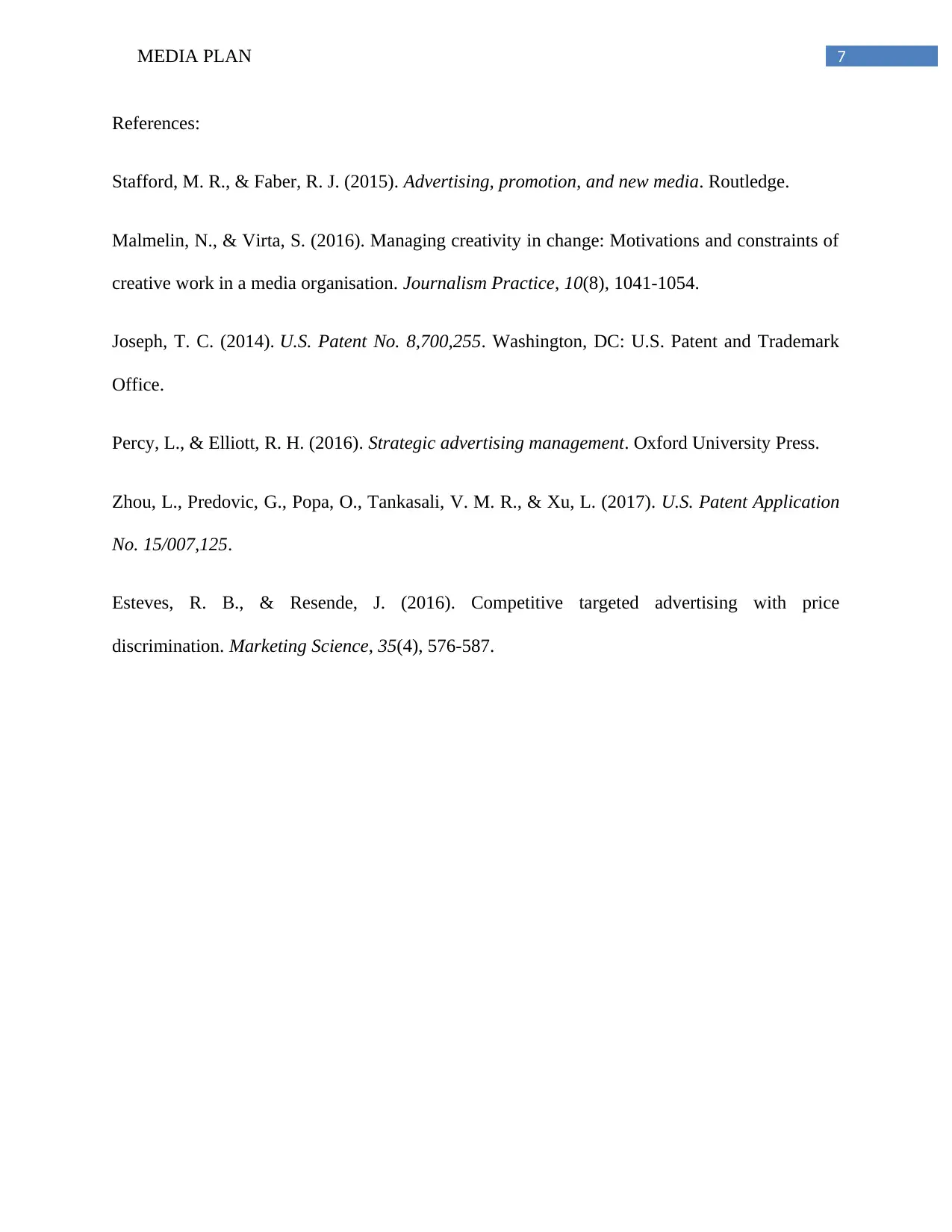
7MEDIA PLAN
References:
Stafford, M. R., & Faber, R. J. (2015). Advertising, promotion, and new media. Routledge.
Malmelin, N., & Virta, S. (2016). Managing creativity in change: Motivations and constraints of
creative work in a media organisation. Journalism Practice, 10(8), 1041-1054.
Joseph, T. C. (2014). U.S. Patent No. 8,700,255. Washington, DC: U.S. Patent and Trademark
Office.
Percy, L., & Elliott, R. H. (2016). Strategic advertising management. Oxford University Press.
Zhou, L., Predovic, G., Popa, O., Tankasali, V. M. R., & Xu, L. (2017). U.S. Patent Application
No. 15/007,125.
Esteves, R. B., & Resende, J. (2016). Competitive targeted advertising with price
discrimination. Marketing Science, 35(4), 576-587.
References:
Stafford, M. R., & Faber, R. J. (2015). Advertising, promotion, and new media. Routledge.
Malmelin, N., & Virta, S. (2016). Managing creativity in change: Motivations and constraints of
creative work in a media organisation. Journalism Practice, 10(8), 1041-1054.
Joseph, T. C. (2014). U.S. Patent No. 8,700,255. Washington, DC: U.S. Patent and Trademark
Office.
Percy, L., & Elliott, R. H. (2016). Strategic advertising management. Oxford University Press.
Zhou, L., Predovic, G., Popa, O., Tankasali, V. M. R., & Xu, L. (2017). U.S. Patent Application
No. 15/007,125.
Esteves, R. B., & Resende, J. (2016). Competitive targeted advertising with price
discrimination. Marketing Science, 35(4), 576-587.
1 out of 8
Related Documents
Your All-in-One AI-Powered Toolkit for Academic Success.
+13062052269
info@desklib.com
Available 24*7 on WhatsApp / Email
![[object Object]](/_next/static/media/star-bottom.7253800d.svg)
Unlock your academic potential
Copyright © 2020–2025 A2Z Services. All Rights Reserved. Developed and managed by ZUCOL.


